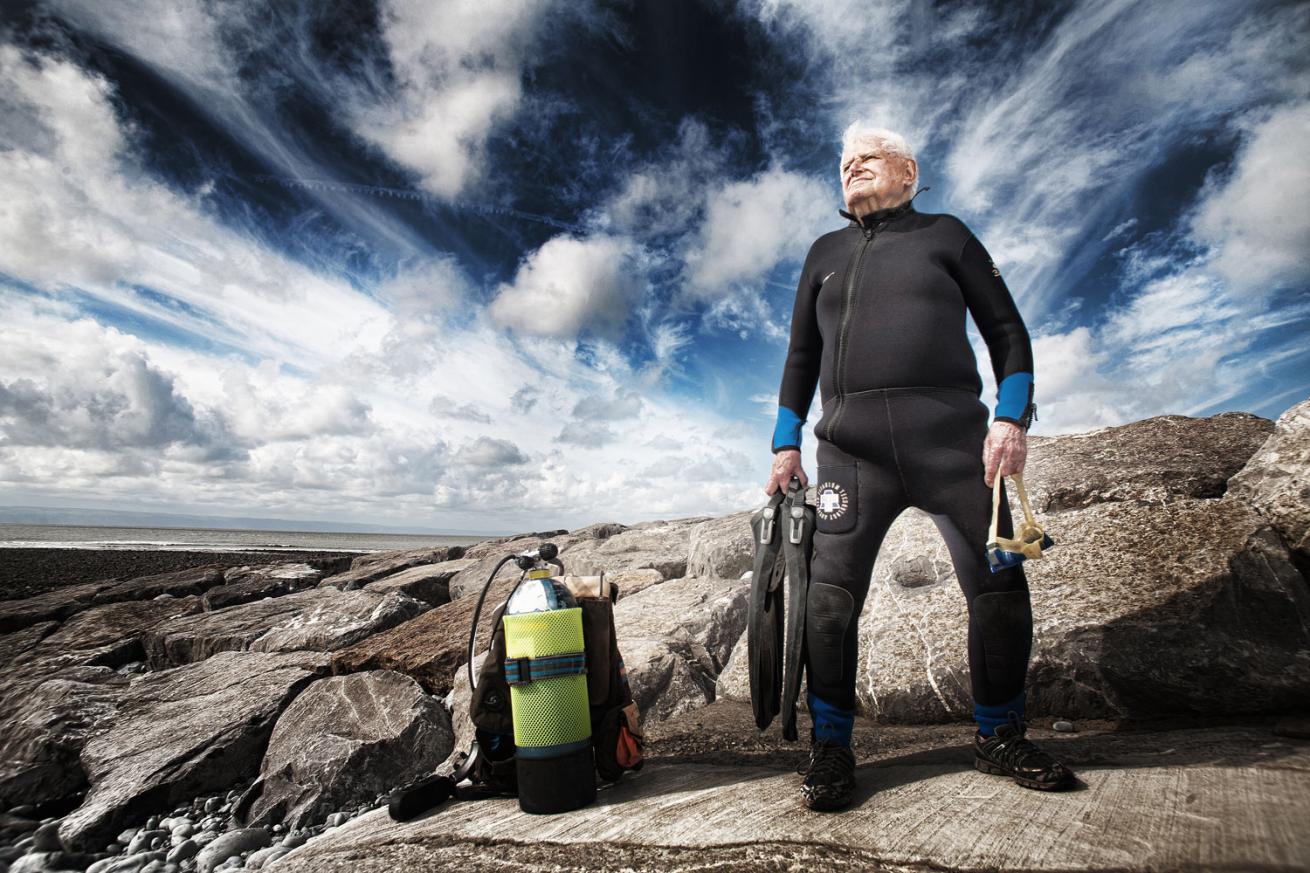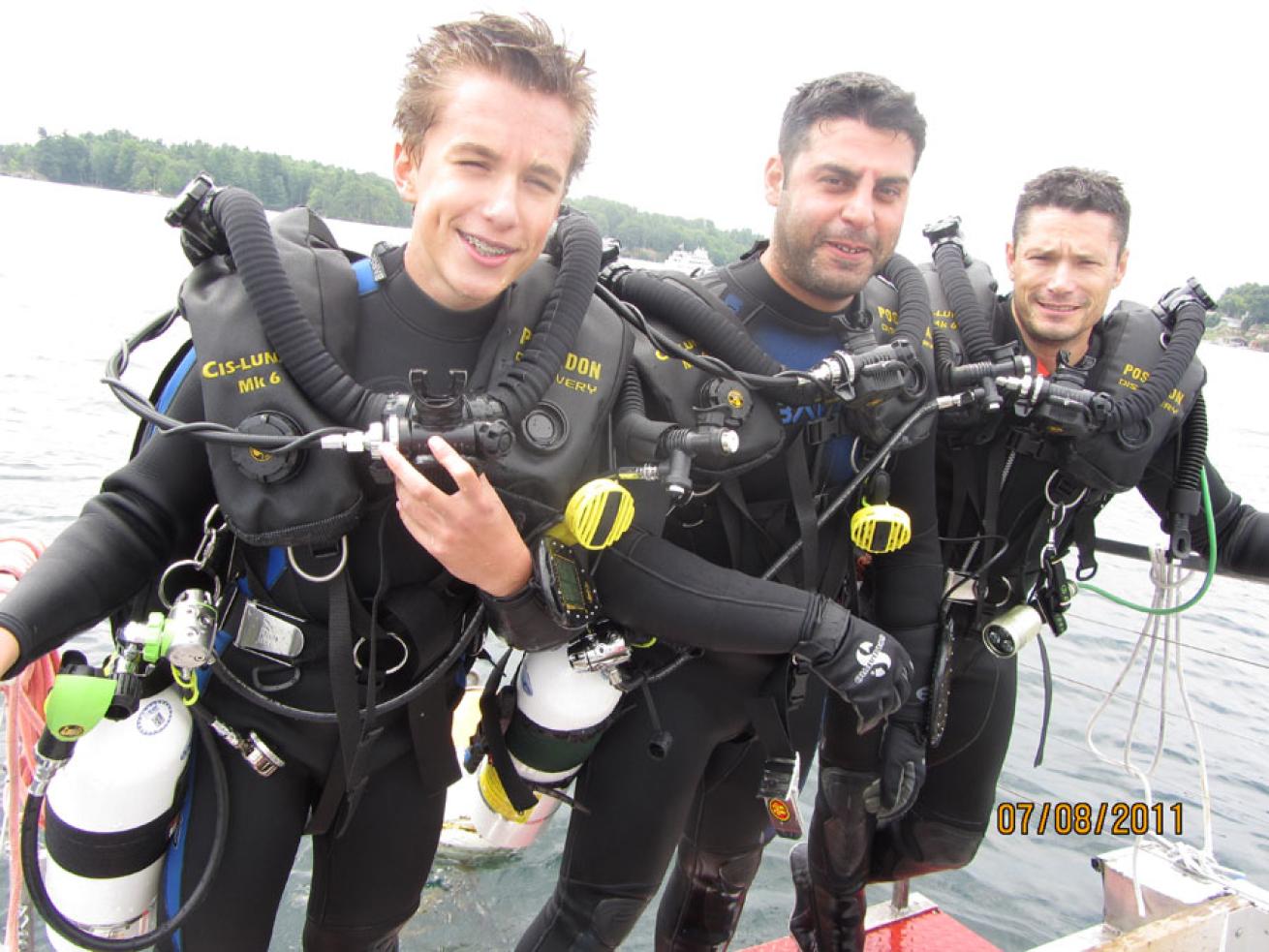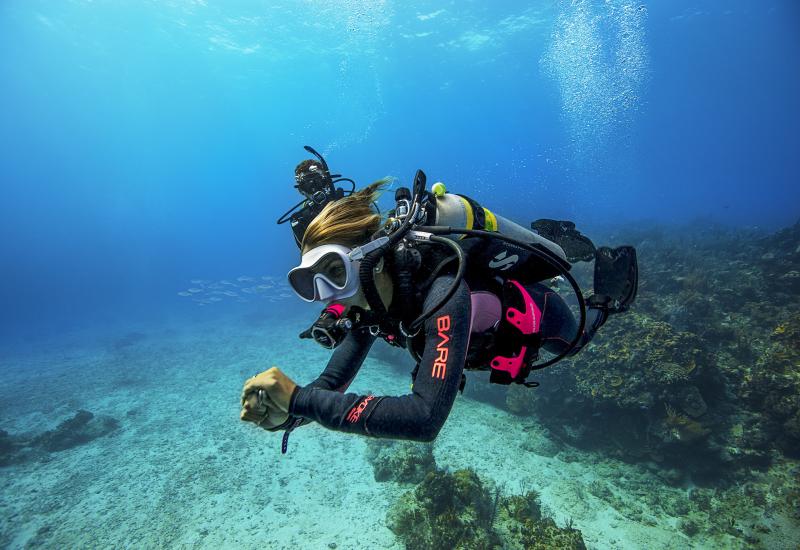What It's Like ... To Be the World's Oldest Diver

Norman Lancefield Photo
Richard Walton
We published the following autobiographical profile, in Norman Lancefield's own words, in Scuba Diving's November/December 2011 issue. At 91, Norman is believed to be the world's oldest active diver. We are inspired by Norman's passion for diving, as well as 15-year-old Lucas Barroso's determination to get his rebreather certification — the youngest person to achieve that certification in Canada, if not the world. Here are their stories.
The World's Oldest Diver
I’m 91 and have been diving with the same gear since 1970. Like me, it’s still going strong after more than 500 dives. My hips don’t stick out far enough, so I can’t wear a weight belt; instead, I rely on a harness and I make my own weights with melted lead shaped in loaf tins. This setup has worked for me in Malta, Mexico, Turkey and my favorite destination, the Gulf of Aqaba in the Red Sea. I have swum with sharks and dolphins, but at my age you don’t need obvious excitement. Even a hermit crab can be thrilling — they’re funny creatures, living in second-hand seashells.
Diving isn’t a dangerous sport; it is a hazardous sport and my goal is to avoid the hazards. A buddy helps me into the water, but after that, once I’m in I do fine.
I don’t do strong currents — those days are long gone. I don’t go too deep either. I’m not as physically fit as I used to be, but that’s why I like diving: I tell anyone looking to take up the sport that you don’t need to be an Olympic swimmer. I’m noticeably slow in the water, but I still swim 500 meters three times a week.
Because of this, I could swim all day if I had to. It’s important to me that I keep up with my buddies in the Barry Sub Aqua Club here in Wales. I also make a point of testing my gear regularly. It sits in a closet all winter, so I kit up in a local pool before each season. I’d rather find problems when I am only six feet deep.
Only once have I been scared in the water. My mask flooded completely — I had placed part of the seal atop my hood. I lit my torch, spun wildly in a circle and realized I had lost my buddy. But I surfaced after one minute and returned to the boat. There was my buddy waiting for me.
It’s important for divers — of any age — to know when to say no. You don’t want to put a buddy at risk. I had a mild attack of the flu 18 months ago, and had to sit out on a planned dive. But for the most part, I stay fit. As long as I can keep going and not be too much nuisance to my buddy, I will keep diving.
Canada's Youngest Rebreather Diver

Canadian Lucas Barroso, pictured at left, is a rebreather diver. Nothing special about that — there are thousands of rebreather divers in Canada — except Lucas Barroso is so young he only just received his driver’s license, making him possibly Canada’s youngest rebreather diver.
The 16-year-old is an A student at Huron Heights secondary school and a member of the Huron Heights swim team. He’s been attracted to the water since he was a child and became interested in diving at young age. “When I got the opportunity to dive open circuit at 12 I didn’t hesitate,” he said. Lucky then that his father is a rebreather instructor with PADI, TDI and RAID, who also helped him get his rebreather certification on the Poseidon Discovery MK6 with RAID. “When I was 15 I decided to get my rebreather license, and I’ve been diving it ever since.”
Scuba Diving: Why did you want to be rebreather trained? Was it “boredom” with open-circuit, did you want to challenge yourself, is there a specific destination you want to get to for rebreathers?
Lucas Barroso: I had a tendency to run out of air quite quickly compared to most divers. When the MK6 came out and it became easier to dive rebreather I jumped on the idea. I have always wanted to visit Truk Lagoon like my dad did, and now that I dive rebreather I can dive long enough to really see the shipwrecks there.
SD: Does anyone else in your family dive rebreathers?
LB: Yes, my dad also uses a rebreather and dives it on a regular basis.
SD: What was the most difficult aspect of your rebreather training?
LB: Dealing with the stage bottle was the hardest thing I had to overcome because it was 1/2 my weight! Also buoyancy was a problem — on rebreather you do not rise and fall with each breath, so you could stay in the same spot and hover. Or sink like a stone!
SD: Do you think rebreathers have an unfair reputation as being “too technical” or “too difficult”?
LB: They do have a reputation of being too technical, but I assure you, it’s something many people can handle. The new ones, especially the Poseidon, make it a lot easier.
SD: Does being so young possibly confer to people that rebreathers can be used in a more recreational setting, and by divers of all ages?
LB: Yes, though most rebreathers are aimed for a technical and military audience, more and more models are coming out for the “average Joe.”
SD: Where’s your first rebreather trip planned?
LB: I have no idea. I’d like to join my dad in Florida to dive the wrecks in the Keys, but I’m excited to go wherever the current takes me!
SD: What’s up next in your training?
LB: The wreck penetration course. I have the time, so now I need something to do while I’m down there.
SD: What other passions do you have besides scuba diving?
LB: Mixed Martial Arts and snowboarding. I like to balance my activities as much as possible — MMA and snowboarding are high-intensity, high-adrenaline sports and scuba diving is the calming and peaceful counterpoint.

Richard Walton
We published the following autobiographical profile, in Norman Lancefield's own words, in Scuba Diving's November/December 2011 issue. At 91, Norman is believed to be the world's oldest active diver. We are inspired by Norman's passion for diving, as well as 15-year-old Lucas Barroso's determination to get his rebreather certification — the youngest person to achieve that certification in Canada, if not the world. Here are their stories.
The World's Oldest Diver
I’m 91 and have been diving with the same gear since 1970. Like me, it’s still going strong after more than 500 dives. My hips don’t stick out far enough, so I can’t wear a weight belt; instead, I rely on a harness and I make my own weights with melted lead shaped in loaf tins. This setup has worked for me in Malta, Mexico, Turkey and my favorite destination, the Gulf of Aqaba in the Red Sea. I have swum with sharks and dolphins, but at my age you don’t need obvious excitement. Even a hermit crab can be thrilling — they’re funny creatures, living in second-hand seashells.
Diving isn’t a dangerous sport; it is a hazardous sport and my goal is to avoid the hazards. A buddy helps me into the water, but after that, once I’m in I do fine.
I don’t do strong currents — those days are long gone. I don’t go too deep either. I’m not as physically fit as I used to be, but that’s why I like diving: I tell anyone looking to take up the sport that you don’t need to be an Olympic swimmer. I’m noticeably slow in the water, but I still swim 500 meters three times a week.
Because of this, I could swim all day if I had to. It’s important to me that I keep up with my buddies in the Barry Sub Aqua Club here in Wales. I also make a point of testing my gear regularly. It sits in a closet all winter, so I kit up in a local pool before each season. I’d rather find problems when I am only six feet deep.
Only once have I been scared in the water. My mask flooded completely — I had placed part of the seal atop my hood. I lit my torch, spun wildly in a circle and realized I had lost my buddy. But I surfaced after one minute and returned to the boat. There was my buddy waiting for me.
It’s important for divers — of any age — to know when to say no. You don’t want to put a buddy at risk. I had a mild attack of the flu 18 months ago, and had to sit out on a planned dive. But for the most part, I stay fit. As long as I can keep going and not be too much nuisance to my buddy, I will keep diving.
Canada's Youngest Rebreather Diver

Canadian Lucas Barroso, pictured at left, is a rebreather diver. Nothing special about that — there are thousands of rebreather divers in Canada — except Lucas Barroso is so young he only just received his driver’s license, making him possibly Canada’s youngest rebreather diver.
The 16-year-old is an A student at Huron Heights secondary school and a member of the Huron Heights swim team. He’s been attracted to the water since he was a child and became interested in diving at young age. “When I got the opportunity to dive open circuit at 12 I didn’t hesitate,” he said. Lucky then that his father is a rebreather instructor with PADI, TDI and RAID, who also helped him get his rebreather certification on the Poseidon Discovery MK6 with RAID. “When I was 15 I decided to get my rebreather license, and I’ve been diving it ever since.”
Scuba Diving: Why did you want to be rebreather trained? Was it “boredom” with open-circuit, did you want to challenge yourself, is there a specific destination you want to get to for rebreathers?
Lucas Barroso: I had a tendency to run out of air quite quickly compared to most divers. When the MK6 came out and it became easier to dive rebreather I jumped on the idea. I have always wanted to visit Truk Lagoon like my dad did, and now that I dive rebreather I can dive long enough to really see the shipwrecks there.
SD: Does anyone else in your family dive rebreathers?
LB: Yes, my dad also uses a rebreather and dives it on a regular basis.
SD: What was the most difficult aspect of your rebreather training?
LB: Dealing with the stage bottle was the hardest thing I had to overcome because it was 1/2 my weight! Also buoyancy was a problem — on rebreather you do not rise and fall with each breath, so you could stay in the same spot and hover. Or sink like a stone!
SD: Do you think rebreathers have an unfair reputation as being “too technical” or “too difficult”?
LB: They do have a reputation of being too technical, but I assure you, it’s something many people can handle. The new ones, especially the Poseidon, make it a lot easier.
SD: Does being so young possibly confer to people that rebreathers can be used in a more recreational setting, and by divers of all ages?
LB: Yes, though most rebreathers are aimed for a technical and military audience, more and more models are coming out for the “average Joe.”
SD: Where’s your first rebreather trip planned?
LB: I have no idea. I’d like to join my dad in Florida to dive the wrecks in the Keys, but I’m excited to go wherever the current takes me!
SD: What’s up next in your training?
LB: The wreck penetration course. I have the time, so now I need something to do while I’m down there.
SD: What other passions do you have besides scuba diving?
LB: Mixed Martial Arts and snowboarding. I like to balance my activities as much as possible — MMA and snowboarding are high-intensity, high-adrenaline sports and scuba diving is the calming and peaceful counterpoint.










